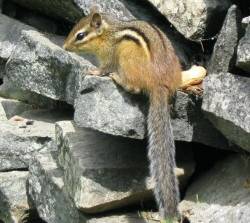- Eastern Chipmunk
Taxobox
name = Eastern Chipmunk
status = LR/lc | status_system = IUCN2.3

regnum =Animal ia
phylum =Chordata
classis =Mammal ia
ordo =Rodent ia
familia =Sciuridae
genus = "Tamias"
species = "T. striatus"
binomial = "Tamias striatus"
binomial_authority = (Linnaeus,1758 )The Eastern Chipmunk, "Tamias striatus", is a smallsquirrel -likerodent found in easternNorth America , a member of thechipmunk genus , "Tamias".They have reddish-brown fur on their upper parts with 5 dark brown stripes and contrasting light brown stripes along their backs and light underparts. They have a tawny stripe that goes from their whiskers to below their ears and light stripes over their eyes. They have a dark tail. Like other chipmunks, they transport food in pouches in their cheeks.
They live in
deciduous woods and urban parks in southernCanada and the easternUnited States . They prefer locations with rocky areas and shrubs to provide cover.They climb trees well but construct underground
nests with extensive tunnel systems, often with several entrances. They store food in their burrows. During winter, these animals enter long periods oftorpor , but do not truly hibernate.These animals are mainly active during the day, spending most of their day foraging for food. They eat bulbs, seeds, fruits, nuts, green plants, mushrooms,
insects , worms, and bird eggs. Predators includehawk s,fox es,raccoon s,weasel s,snake s, andcat s.Eastern chipmunks defend their burrows and live solitary lives, except during mating. Females produce 1 or 2 litters of 4 to 5 young. They have two breeding seasons. One goes from February to April, the other June to August. The expected lifespan of "Tamias striatus" in the wild is perhaps a year; in captivity it may live eight years. On average they live 2-3 years.
In order to hide their burrow, eastern chipmunks will carry the dirt that they excavate to a different location in their cheek pouches. Since they are an easy prey species, they have to hide their burrows. They also line their burrows with leaves, rocks, sticks, and other material. This makes them even harder to see.
They have several
bird -like chipping calls that give them their name.Gallery
References
*
* [http://animaldiversity.ummz.umich.edu.site/accounts/information/Tamias_striatus.html]
* Dr. Lawrence Wishner. Eastern Chipmunks: Secrets of Their Solitary Lives. 1982. Smithsonian Institution Press, Washington DC. ISBN 0-87474-962-X
Wikimedia Foundation. 2010.
